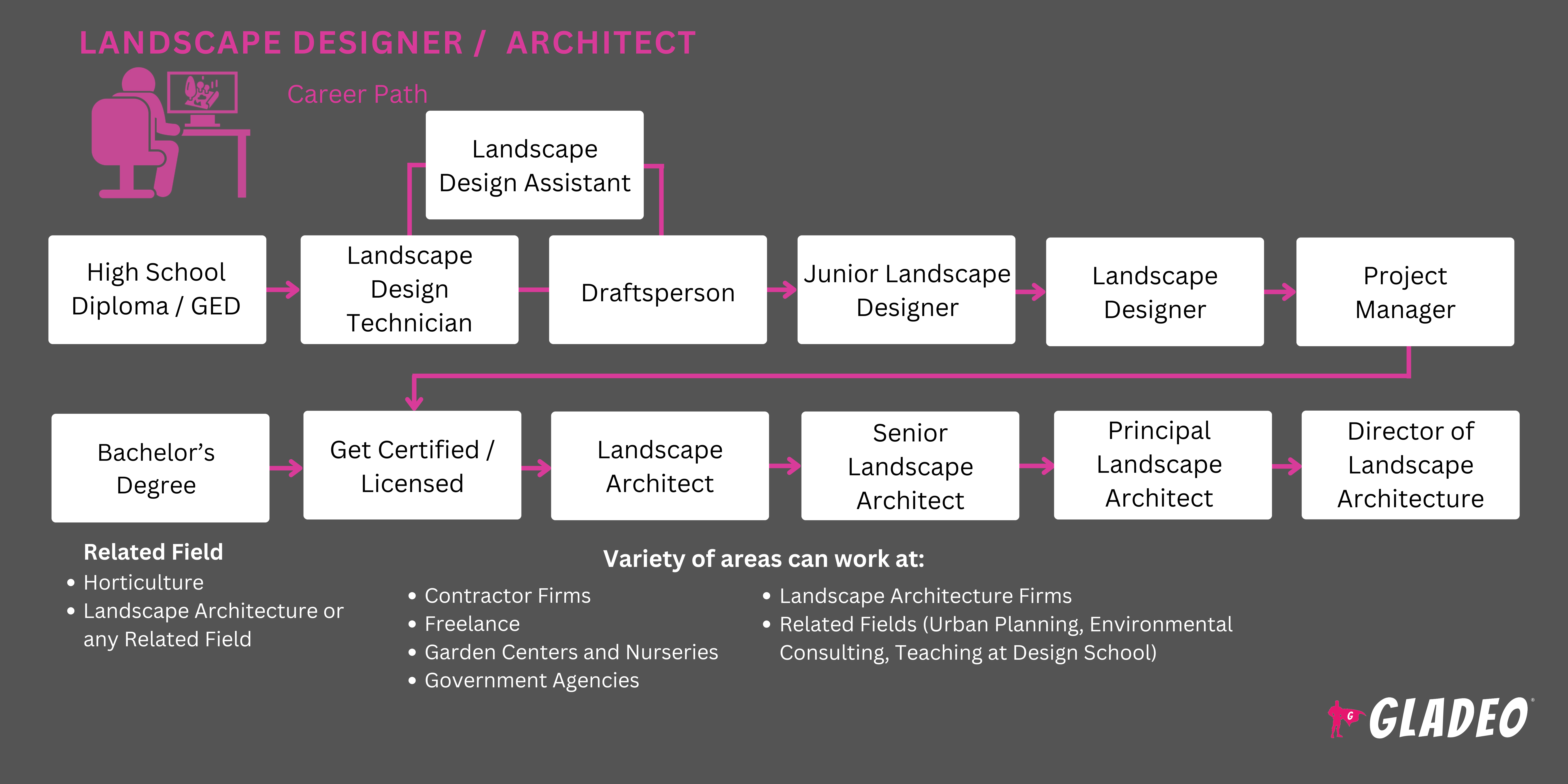Прожекторы
Архитектор, архитектор гольф-поля, планировщик территории, ландшафтный архитектор, планировщик ландшафта, планировщик парков, планировщик, профессиональный ландшафтный архитектор (PLA), ландшафтный консультант, дизайнер сада, дизайнер открытого пространства, менеджер ландшафтных проектов, планировщик участка, городской дизайнер, дизайнер парка, ландшафтный художник
Ландшафтные дизайнеры и ландшафтные архитекторы используют растения, деревья и рукотворные элементы, такие как фонтаны и светильники, чтобы оживить открытые пространства!
Эти профессионалы ландшафтного дизайна превращают парки, сады, общественные пространства, корпоративные и университетские кампусы, медицинские парки и домашние дворы в красивые, экологически чистые места, способствующие здоровью и спокойствию. Они буквально помогают формировать наше восприятие природы!
Для этого они сочетают творчество с наукой, тесно сотрудничая с архитекторами и градостроителями, чтобы обеспечить устойчивость и визуальную привлекательность каждого проекта. Все продумано до мельчайших деталей, от дренажа и состояния почвы до мест для отдыха и выбора растений, создавая пространства, которые соединяют людей с природой и одновременно решают экологические проблемы.
Основные различия между ландшафтными дизайнерами и ландшафтными архитекторами заключаются в их квалификации, масштабах проектов и сферах деятельности. Например, ландшафтные архитекторы обычно имеют ученую степень и лицензию, что позволяет им управлять крупными проектами, которые предполагают сложное планирование участка, оценку воздействия на окружающую среду и сотрудничество с инженерами.
Ландшафтные дизайнеры занимаются небольшими проектами для жилых домов и, как правило, не требуют диплома или лицензии. Их работа сосредоточена на эстетическом подборе растений и проектировании планировки, украшая пространство без структурной направленности, необходимой в более крупных проектах.
- Превращение открытых пространств в красивые и функциональные зоны
- Вклад в обеспечение экологической устойчивости
- Работа на свежем воздухе с природой
- Сохранение растений, кустарников и деревьев здоровыми и защищенными от вредителей
- Ежедневные физические упражнения
- Сотрудничество с профессионалами в различных областях
График работы
Ландшафтные дизайнеры и ландшафтные архитекторы обычно работают полный рабочий день, в некоторых случаях возможна сверхурочная работа. Они распределяют свое время между офисами и открытыми площадками, координируя работу с клиентами, подрядчиками и другими заинтересованными сторонами.
Типичные обязанности
Обратите внимание, что обязанности различаются в зависимости от того, кто является ландшафтным дизайнером или ландшафтным архитектором.
- Встречайтесь с клиентами для изучения их идей, требований к проекту, сроков и бюджетов.
- Посетите предполагаемые участки, чтобы оценить особенности земли, состояние почвы и другие факторы окружающей среды, например, ожидаемое количество осадков.
- Использовать географические информационные системы для сбора и анализа данных о географии участка.
- Анализируйте экологические отчеты для решения таких вопросов, как дренаж, борьба с эрозией и использование энергии.
- Разработка концепций и чертежей. Интегрируйте в проекты природные особенности местности, такие как деревья и источники воды. Рассмотрение проектов с клиентами.
- Учитывайте пожелания клиентов и создавайте подробные планы объекта, спецификации и сметы.
- Используйте программное обеспечение для автоматизированного проектирования и черчения для подготовки графических изображений.
- Выбирайте экологичные материалы и растения, совместимые с климатом и почвой участка.
- Планируйте экономию воды, используя засухоустойчивые растения и эффективный полив.
- Включайте элементы зеленой инфраструктуры, такие как зеленые крыши и дождевые сады, системы сбора дождевой и серой воды.
- Разработать стратегии управления ливневыми стоками для предотвращения эрозии.
- Разработайте макеты пешеходных дорожек, зон отдыха и освещения, чтобы улучшить доступность и эстетику.
- При необходимости координировать работу со сметчиками, архитекторами, инженерами, строительным персоналом и субподрядчиками.
- Представляйте окончательные предложения по дизайну клиентам, государственным учреждениям или заинтересованным сторонам сообщества для утверждения.
- Управление сроками и качеством проекта. Посещение объектов во время выполнения работ. Проверяйте материалы, строительные стандарты и соответствие плану.
Дополнительные обязанности
- Проводить последующие консультации с клиентами.
- Подготовьте визуальные изображения, иллюстрирующие предполагаемый рост ландшафта.
- Создайте сезонные планы посадки растений.
- Следите за тенденциями в дизайне, технологиями и устойчивыми практиками.
- Планируйте восстановление природных ландшафтов (например, водно-болотных угодий).
- Разработка маркетинговых стратегий для рекламы услуг.
Мягкие навыки
- Внимание к деталям
- Сотрудничество
- Общение
- Творчество
- Ориентированность на обслуживание клиентов
- Наблюдательный
- Пациент
- Решение проблем
- Ориентированные на безопасность
- Сильные навыки слушания
- Работа в команде
- Управление временем
Технические навыки
- Ландшафтные дизайнеры и ландшафтные архитекторы должны знать следующее:
- Программное обеспечение для 3D-моделирования (например, SketchUp, Rhino)
- Программное обеспечение для проектирования (например, AutoCAD, GIS)
- Методы строительства и материалы
- Оценка затрат и бюджетирование
- Геодезические работы и методы измерения земли
- Техническое рисование и черчение
- Управление проектами
- Государственные и местные стандарты безопасности
- Экологические и зонирующие нормы
- Спринклерные и осветительные системы
- Стратегии борьбы с эрозией
- Садоводство и уход за растениями
- Почвоведение и дренажные системы
- Системы ирригации и управления водными ресурсами
- Планирование адаптации к климату и устойчивости
- Устойчивые ландшафтные практики
- Пестициды и удобрения
- Ландшафтная экология и биоразнообразие
- Бюро ландшафтной архитектуры
- Строительные и инжиниринговые компании
- Государственные учреждения (например, городские отделы планирования, парки и места отдыха, военные базы)
- Застройщики недвижимости
- Экологические организации
- Торговые центры и торговые площадки
- Корпоративная штаб-квартира
- Медицинские учреждения
- Колледжи и университеты
Ландшафтные дизайнеры и ландшафтные архитекторы должны сочетать творческий подход с функциональностью, чтобы создавать визуально привлекательные, практичные и устойчивые проекты. Это требует решения множества проблем и гибкости, поскольку они учитывают такие факторы, как бюджетные ограничения, воздействие на окружающую среду и нормативные требования.
Кроме того, не всегда легко удовлетворить требования клиента в рамках желаемого бюджета и сроков. Когда проекты отстают от графика или расходы превышают бюджет, напряженность может быть очень высокой! Вот почему открытое, постоянное общение имеет большое значение.
Работники этой сферы проводят много времени на улице, посещая объекты, контролируя ход работ и следя за соблюдением проектных планов. Это требует выносливости, а также стремления к обеспечению качества и умения работать с людьми для достижения общих целей.
В ландшафтном дизайне и архитектуре все больше внимания уделяется вопросам устойчивости, жизнестойкости и интеграции технологий - от жилых ландшафтов до коммерческих и промышленных проектов. На самом деле, стремление к устойчивости никогда не было столь сильным, поскольку все больше внимания уделяется зеленой инфраструктуре, такой как экологически чистые дождевые сады и биопруды, использование местных растений, зеленые крыши, проницаемые твердые покрытия и живые стены, которые управляют ливневыми водами, уменьшают загрязнение и охлаждают городские районы.
Что касается устойчивости, то стратегии устойчивого проектирования направлены на решение климатических проблем, таких как наводнения и экстремальная жара, и включают в себя адаптивные растения и методы смягчения последствий стихийных бедствий.
В то же время такие передовые инструменты, как 3D-моделирование и географические информационные системы, повышают точность и эффективность планирования, а картографирование с помощью беспилотников и виртуальная реальность способствуют визуализации проектов и оценке участков.
Многие ландшафтные архитекторы с самого начала интересовались искусством, дизайном, природой, растениями и садоводством. Возможно, они интересовались экологией, биологией или изучением окружающей среды, что позволило им понять, как работают природные системы.
- Ландшафтным дизайнерам требуется как минимум диплом о среднем образовании или GED. Полезными могут быть занятия в муниципальном колледже, связанные с дизайном, садоводством и огородничеством.
- Обычно им не нужны никакие сертификаты или лицензии.
- Ландшафтные архитекторы должны иметь как минимум степень бакалавра ландшафтной архитектуры или бакалавра наук в области ландшафтной архитектуры по программе, одобренной Советом по аккредитации ландшафтных архитекторов. ~18% из них имеют степень магистра.
- Каждый штат требует от ландшафтных архитекторов наличия лицензии. Сначала они должны сдать регистрационный экзамен для ландшафтных архитекторов (LARE), который проводится Советом регистрационных советов ландшафтных архитекторов. Право на сдачу экзамена зависит от штата.
- Экзамен охватывает такие темы, как:
■ Инвентаризация, анализ и управление проектами
■ Планирование и дизайн
■ Строительная документация и администрирование
■ Грейдирование, дренаж и управление ливневыми водами
- В некоторых штатах требуется дополнительное тестирование в дополнение к LARE.
- Дополнительные сертификаты включают:
- Ассоциация администраторов физических установок - Профессионал в области образовательных учреждений
- Ассоциация профессиональных ландшафтных дизайнеров - сертифицированный профессиональный ландшафтный дизайнер
- Ассоциация государственных менеджеров по наводнениям - сертифицированный менеджер по наводнениям
- Конгресс за новый урбанизм - Программа аккредитации CNU
- Институт строительных спецификаций - сертифицированный специалист по строительным спецификациям
- Design-Build Institute of America - сертификат Design-Build Professional
- Агентство по охране окружающей среды - квалифицированный ландшафтный дизайнер по водосбережению
- Институт сертификации ГИС - Профессионал в области географических информационных систем
- Ассоциация строителей гольф-полей Америки - сертифицированный строитель гольф-полей
- Зеленые крыши для здоровых городов - Green Roof Professional
- Институт устойчивой инфраструктуры - Envision Sustainability Professional
- EnviroCert - сертифицированный специалист по борьбе с эрозией и осадками и национальная сертификация зеленой инфраструктуры
- Международный институт "Живое будущее" - аккредитация "Живое будущее
- Международное общество арборикультуры - дипломы сертифицированного арбориста
- Управление инвазивными растениями - сертифицированный менеджер по инвазивным растениям
- Ассоциация ирригации - Сертифицированный дизайнер ирригации - Ландшафт
- Национальная ассоциация профессионалов ландшафтного дизайна - сертифицированный ландшафтный техник
- Национальный институт по предотвращению преступлений - профессиональная сертификация "Предотвращение преступлений через дизайн окружающей среды
- Национальная ассоциация рекреации и парков - сертифицированный специалист по паркам и рекреации
- Национальный центр ливневых вод - сертифицированный инспектор ливневых вод
- Северо-восточная ассоциация органического земледелия - аккредитованный специалист по уходу за органическими землями
- Project Management Institute - Project Management Professional
- Общество экологического восстановления - сертифицированный специалист по экологическому восстановлению
- Общество почвоведов Америки - сертифицированный профессиональный почвовед
- Sustainable Sites Initiative - аккредитованный специалист SITES
- Центр дизайна здоровья - аккредитация и сертификация дизайна, основанного на доказательствах
- Совет по экологическому строительству США - аккредитованный специалист LEED
- Всемирная академия парков - сертифицированный специалист по паркам
- Программы по ландшафтной архитектуре должны быть аккредитованы Советом по аккредитации ландшафтных архитекторов.
- Ищите программы, предлагающие опыт работы в полевых условиях и оснащенные современным оборудованием и инструментами.
- Рассмотрите стоимость обучения, скидки и возможности получения местных стипендий (в дополнение к федеральной помощи).
- Изучите показатели выпуска и статистику трудоустройства после окончания учебы.
- Подумайте о своем расписании и гибкости, принимая решение о зачислении на программу в кампусе, онлайн или гибридную программу. Некоторые занятия, скорее всего, придется проводить лично, чтобы получить реальный практический опыт.
- Пройдите курсы по искусству, биологии, экологии, наукам о Земле, химии и физике; также полезны занятия с углубленным изучением предметов.
- Получите опыт, проходя стажировку или работая неполный рабочий день в ландшафтных, дизайнерских фирмах или экологических организациях.
- Развивайте навыки рисования, использования программного обеспечения для проектирования и географических информационных систем.
- Участвуйте в работе клубов по экологии, устойчивому развитию и геологии.
- Создайте портфолио, демонстрирующее дизайн-проекты, полевые работы, картографирование и анализ данных.
- Участвуйте в научных выставках, командных проектах и лидерских мероприятиях, чтобы улучшить навыки работы в команде и управления проектами.
- Будьте в курсе новых инструментов, программного обеспечения и тенденций, читая отраслевые издания, такие как Landscape Journal, и просматривая обучающие видео.
- Попросите провести информационное интервью с работающим специалистом. Провести день за работой - тоже отличный способ обучения!
- Начните налаживать связи, посещая отраслевые мероприятия, участвуя в онлайн-форумах и вступая в профессиональные организации, такие как Американское общество ландшафтных архитекторов.
- Поддерживайте контакты с профессорами, наставниками и коллегами, которые могут послужить рекомендациями и предложить профориентацию.

- Воспользуйтесь услугами карьерного центра вашего учебного заведения, чтобы получить помощь в составлении резюме и поиске работы.
- Узнайте у специалистов по ландшафтному дизайну из своей сети о вакансиях.
- Проверьте такие порталы вакансий, как Indeed.com, LinkedIn, Glassdoor, Monster, CareerBuilder, SimplyHired, ZipRecruiter, USAJOBS, а также сайты местных работодателей.
- Если у вас нет достаточного опыта, ищите стажировки, практику или должности начального уровня в фирмах, занимающихся ландшафтным дизайном и архитектурой.
- Подготовьте сильное резюме и портфолио, в котором будут отражены ваши дизайнерские проекты, навыки работы с программным обеспечением и любой практический опыт. Обратите внимание на ключевые слова, используемые в объявлениях о вакансиях, например:
- Экологические оценки
- Полевое картирование
- Географические информационные системы
- Выбор растений и знания по садоводству
- Анализ сайта
- Устойчивый дизайн
- Городское планирование
- Просмотрите примеры резюме и включите в них подходящие ключевые слова.
- Изучите общие вопросы для собеседования, чтобы быть готовым. Примерные вопросы для собеседования могут включать такие, как "Как вы подходите к балансу между эстетической привлекательностью и экологической устойчивостью в проекте ландшафтного дизайна?" или "Опишите случай, когда вы столкнулись со сложными условиями на участке. Как вы адаптировали свой проект, чтобы учесть это?".
- Пройдите пробные собеседования, чтобы обрести уверенность. Проявите неподдельный энтузиазм по отношению к ландшафтной архитектуре и любым областям, в которых вы хотите специализироваться, например, устойчивому дизайну или городскому планированию.
- Одевайтесь на собеседования соответствующим образом.
- Обратитесь к своему руководителю за советом по планированию карьеры. Дайте им понять, что вы заинтересованы в продвижении по карьерной лестнице и готовы браться за все более сложные проекты.
- Если вы ландшафтный дизайнер без степени бакалавра, закончите бакалавриат по ландшафтной архитектуре или бакалавриат по ландшафтной архитектуре и получите лицензию.
- Если вы ландшафтный архитектор со степенью бакалавра, получите степень магистра ландшафтной архитектуры.
- Пройдите курсы повышения квалификации и получите сертификат продвинутого уровня, например SITES Accredited Professional или LEED Accredited Professional.
- Установите прочные отношения с регулирующими органами.
- Обращайтесь за наставничеством к опытным профессионалам ландшафтного дизайна. Наставляйте молодых дизайнеров, делясь с ними своими идеями и рекомендациями.
- Постоянно обновлять отраслевые инструменты и технологии, осваивая такие программы, как AutoCAD, ArcGIS и Adobe Creative Suite.
- Вступайте в профессиональные организации, публикуйте статьи, выступайте на конференциях и участвуйте в отраслевых мероприятиях.
- Отслеживайте внутренние вакансии и следите за внешними, если это необходимо для продвижения по карьерной лестнице.
- Рассмотрите возможность переезда в регионы с высоким спросом на ландшафтных дизайнеров и архитекторов, такие как Нью-Йорк, Калифорния, Флорида, Техас, Пенсильвания, Коннектикут, Мэриленд и Колорадо.
Сайты
- Американский институт сертифицированных планировщиков
- Американская ассоциация планирования
- Американское общество ландшафтных архитекторов
- ArchDaily
- Ассоциация администраторов физического оборудования
- Ассоциация профессиональных ландшафтных дизайнеров
- Ассоциация государственных менеджеров по управлению поймами
- Конгресс за новый урбанизм
- Институт строительных спецификаций
- Совет преподавателей ландшафтной архитектуры
- Совет регистрационных советов ландшафтных архитекторов
- Американский институт проектирования и строительства
- Пульс экостроительства
- EnviroCert
- Ассоциация исследований в области экологического дизайна
- Агентство по охране окружающей среды
- Институт сертификации ГИС
- Ассоциация строителей гольф-полей Америки
- Зеленые крыши
- Зеленые крыши для здоровых городов
- Институт устойчивой инфраструктуры
- Международное общество древоводства
- Национальный информационный центр по инвазивным видам
- Ассоциация ирригации
- Земля8
- Фонд ландшафтной архитектуры
- Журнал "Ландшафтный подрядчик
- Пейзажный журнал
- Живое будущее
- Национальная ассоциация профессионалов ландшафтного дизайна
- Национальная ассоциация рекреации и парков
- Национальный центр ливневых стоков
- Северо-восточная ассоциация органического земледелия
- Planetizen
- Институт управления проектами
- Общество экологического восстановления
- Общество почвоведов Америки
- Инициатива "Устойчивые объекты
- Центр дизайна здоровья
- Фонд культурного ландшафта
- Совет по экологическому строительству США
- Городской земельный институт
- USGBC
- Мировая ландшафтная архитектура
- Всемирная академия парков
Книги
- Дизайн с растениями, автор Пит Удольф
- Стандарты ландшафтной архитектурной графики, автор Леонард Дж. Хоппер
- Стандарты ландшафтной архитектуры, позволяющие экономить время, автор Чарльз В. Харрис
Ландшафтные дизайнеры и ландшафтные архитекторы играют важнейшую роль в создании и поддержании красивых, функциональных и устойчивых открытых пространств. Но для тех, кто хочет рассмотреть альтернативные пути развития карьеры, ознакомьтесь с соответствующими вариантами ниже!
- Архитектор
- Архитектурный и гражданский чертежник
- Ботаник
- Инженер-строитель
- Технолог и техник по гражданскому строительству
- Менеджер по строительству
- Чертежник
- Специалист по восстановлению окружающей среды
- Ученый-эколог
- Флорист
- Садовод
- Гидролог
- Дизайнер интерьера
- Техник питомника
- Техник по геодезии и картографии
- Геодезист
- Специалист по устойчивому развитию
- Градостроитель
Лента новостей

Популярные вакансии

Онлайн-курсы и инструменты







